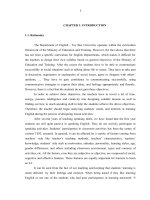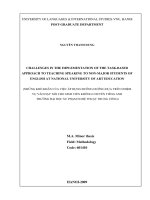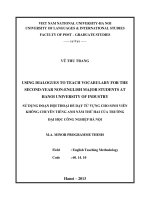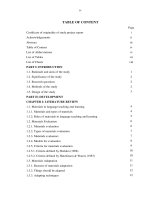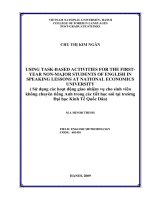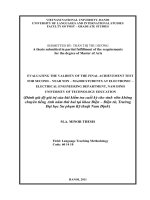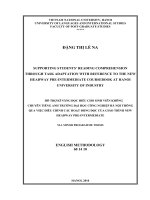Sử dụng tài liệu đọc bổ trợ cho giáo trình Powerbase - Elementary để nâng cao kỹ năng đọc cho sinh viên không chuyên tiếng Anh năm thử nhất trường Đại học Kinh
Bạn đang xem bản rút gọn của tài liệu. Xem và tải ngay bản đầy đủ của tài liệu tại đây (1.41 MB, 86 trang )
HANOI, 2009
FIELD: ENGLISH METHODOLOGY
CODE: 60 14 10
VIETNAM NATIONAL UNIVERSITY
Hanoi University of languages and international studies
Department of posT - graduate studies
NGUYEN THI NGOC HUAN
using supplementary reading materials for the
course book powerbase - elementary to improve
reading skills for first year non- english MAJOR
students at national economics university
(Sử DụNG TàI LIệu Đọc Bổ TRợ cho giáo trình POWERBASE -
ELEMENTARY Để NÂNG CAO Kỹ NĂNG Đọc cho sinh viên không chuyên
tiếng anh năm thứ nhấT tr-ờng đại học kinh tế quốc dâN)
M.A. MINOR THESIS
HANOI, 2009
FIELD: ENGLISH METHODOLOGY
CODE: 60 14 10
SUPERVISOR: PHAN TH VN QUYấN, M.A.
VIETNAM NATIONAL UNIVERSITY
Hanoi University of languages and international studies
Department of posT - graduate studies
NGUYN TH NGC HUN
using supplementary reading materials for the
course book powerbase - elementary to improve
reading skills for first year non- english major
students at national economics university
(Sử DụNG TàI LIệU Đọc Bổ TRợ cho giáo trình POWERBASE - ELEMENTARY
Để NÂNG CAO Kỹ NĂNG Đọc cho sinh viên không chuyên tiếng anh năm
thứ nhất tr-ờng đại học kinh tế quốc dâN)
M.A. MINOR THESIS
vii
TABLE OF CONTENTS
Declaration ………………………………………………………………………… i
Acknowledgements………………………………………………………………… ii
Abstract…………………………………………………………………………… iii
List of Abbreviation………………………………………………………………… iv
List of Tables……………………………………………………………………… v
List of Charts……………………………………………………………………… vi
Table of contents…………………………………………………………………… vii
CHAPTER ONE: INTRODUCTION
1.1. Rationale……………………………………………………………………… 1
1.2. Scope of the study……………………………………………………………. 2
1.3 Significance of the study……………………………………………………… 2
1.4. Aims of the study…………………………………………………………… 2
1.5. Research questions…………………………………………………………… 3
1.6. Methodology………………………………………………………………… . 3
1.7. Design of the study…………………………………………………………… 4
CHAPTER TWO: LITERATURE REVIEW
2.1. Overview of reading………………………………………………………… 5
2.1.1. Definitions of reading…………………………………………………… 5
2.1.2. Reading comprehension……………………………………………… 6
2.1.3. Reading skills………………………………………………………… 7
2.1.3.1. Definition of reading skills…………………………………………. 7
2.1.3.2. Types of reading skills…………………………………………… . 7
2.2. Overview of materials in language teaching………………………………… 8
2.2.1. Definition of materials and types of materials in language teaching… 8
2.2.2. Supplementary materials for language teaching……………………… 9
2.2.3. Materials evaluation and the criteria for reading texts evaluation……… 10
2.2.4. Criteria for selecting appropriate supplementary materials…………… 11
Summary 12
viii
CHAPTER THREE: METHODOLOGY
3.1. Background to the thesis and statement of the problem………………………. 13
3.2. The description of the materials……………………………………………… 14
3.2.1. The course book…………………………………………………………… 14
3.2.1.1.Book title……………………………………………………………… 14
3.2.1.2.Book objectives………………………………………………………. 14
3.2.1.3.The structure of the course book …………………………………… 14
3.2.2. The supplementary material used for the course book …………………… 15
3.3. The subjects……………………………………………………………………. 16
3.4. Instruments for data collection………………………………………………… 17
3.5. Data collection procedures…………………………………………………… 18
3.6. Data analysis…………………………………………………………………… 18
Summary 33
CHAPTER FOUR: MAJOR FINDINGS, DISCUSSION AND
RECOMMENDATIONS
4.1: Major findings and discussion …………………………………………………. 34
4.1.1: The evaluation of the current reading materials used at NEU…………… 34
4.1.1.1: The evaluation of the reading sections in Powerbase………………. 34
4.1.1.2: The evaluations of the current supplementary material ……………. 35
4.1.2. The teachers’ and students’ expectation ………………………………… 36
4.2. Recommendations………………………………………………………………. 37
4.2.1. Suggestions on how to use the course book Powerbase - Elementary……. 37
4.2.1.1. Increasing more time for Reading………………………………………. 38
4.2.1.2. Designing more reading activities and exercises/tasks…………………. 38
4.2.2. Suggestions for selecting supplementary reading materials ……………… 39
4.2.2.1. Suggestions for selecting supplementary reading materials ……………. 39
4.2.2.2. Suggested adaptation of the current SRM for Powerbase……………… 40
Summary 41
ix
CHAPTER FIVE: CONCLUSION
5.1. Conclusion of the study………………………………………………………… 42
5.2. Limitations of the study………………………………………………………… 43
5.3. Suggestions for further study…………………………………………………… 43
REFERENCES I
APPENDICES III
Appendix 1: Questionnaires for teachers…………………………………………. III
Appendix 2: Questionnaires for students…………………………………………. VI
Appendix 3: Samples of supplementary readings for the themes in Powerbase… XII
Appendix 4: Samples of supplementary readings for further readings…………… XXI
Appendix 5: The table of the Macro-skills proportion of the Powerbase………… XXXIV
iv
ABBREVIATIONS
NEU: National Economics University
EFL: English as a foreign language
FL: Foreign language
M.A: Master of Arts
SM: Supplementary material
SRM: Supplementary reading material
P: Powerbase - Elementary
CD: Compact disc
Ts: Teachers
Ss: Students
v
LIST OF TABLES
Table 1: The Ts and Ss’ opinions on the topics of the reading texts in Powerbase 20
Table 2: The Ts and Ss’ opinions on the exercises types of reading texts in Powerbase 21
Table 3: The Ts and Ss’ opinions on the time allocation for reading in Powerbase 22
Table 4: The Ts Ss’ opinions on the length of the reading texts in Powerbase 22
Table 5: The Ts and Ss' opinions on the level of difficulty of the reading texts in Powerbase 23
Table 6: The Ts and Ss’ opinions on the topics of the reading texts in the SM for P 25
Table 7: The Ts and Ss’ opinions on the types of reading exercises in the SM 26
Table 8: The Ts and Ss’ opinions on the time allocation for reading in the SM 27
Table 9: The Ts and Ss’ opinions on the length of the reading texts in the SM 28
Table 10: The Ts and Ss’ opinions on the level of difficulty of the reading texts in the SM 29
Table 11: The Ts and Ss’ opinions on a better SRM for Powerbase 31
Table12: The Macro-skills proportion of the course book Powerbase - Elementary XXXIV
vi
LIST OF CHARTS
Chart 1a: The perception of the Ts about the reading texts in Powerbase 19
Chart 1b: The perception of the Ss about the reading texts in Powerbase 19
Chart 2a: The perception of the Ts about the reading texts in the SM 24
Chart 2b: The perception of the Ss about the reading texts in the SM 24
Chart 3a: The Ts’ attitudes towards the necessary use of SM for 30
Chart 3b: The Ss’ attitudes towards the necessary use of SM for 30
1
CHAPTER ONE: INTRODUCTION
1.1. Rationale
Among the four macro-skills, reading is “by far the most important…, particularly in
English as a second or foreign language” (Carrel, 1981: 1). For many students, reading not
only brings them a lot of interesting information but also provides a variety of linguistic
expressions as well as grammatical structures, which are very useful for them to develop other
skills. Thanks to reading, students can “gain access to the required knowledge that is
available, either exclusively or most readily, in English” (Munby, 1978: 3).
At National Economics University, reading is also regarded as one of the most
important skills that needs to be focused on from the first stage of learning English. Reading
has constantly been tested in the mid-term tests together with either listening or speaking for
many school years. For the first year non-English major students of the school year 2008-
2009, the course book Powerbase – Elementary by David Evans is still in use as it is believed
to be suitable for students of elementary level. Its most updated contents is said to provide
excellent preparation for other English business courses. Powerbase is not a four-skill-focused
material. It is a communicative course book that has been specially written for adults who
need English for work, travel and everyday situations with the two main skills: Listening and
Speaking. In order to help students learn English better and to fulfill the objectives of the
course, before each school year begins, the Faculty of Economics Foreign Languages assign
teachers of each group design the supplementary materials used along with the course books.
The supplementary materials not only provide students with more exercises, but they also
remedy the shortcomings of the course books. The supplementary materials are designed
annually, in which the good points are maintained in but the shortcomings are replaced by the
better ones. The existing supplementary material for Powerbase mainly provides exercises on
grammar, vocabulary and reading. However, through the supplementary book, many students
find it hard to understand the strange, long reading texts with too many new words and new
grammatical structures. Additionally, students are bored with doing only one type of reading
2
exercise. Many student hope to have more readings, but they do not know where to get
appropriate extra reading materials. Consequently, they do not get as high marks at reading
tests as they expected and they lose their interest in reading. Teachers, from time to time,
complain that they have to compile other reading materials to meet the students’ needs and to
make the reading lessons more interesting.
All these reasons have inspired and encouraged me to carry out the study on “Using
supplementary reading materials for „Powerbase – Elementary‟ to improve reading skill for
first year non-English major students at National Economics University” with the hope to
make some contributions to improving the teaching and learning of reading for first year non-
English major students at NEU.
1.2. Scope of the study
Due to the limited time and the size of a minor thesis, the researcher has no ambitions
to cover all aspects of reading, such as reading in integration with other skills: speaking,
listening, and writing , but only focuses on the use of supplementary reading materials to
develop reading skills for first year non-English major students at NEU.
1.3. Significance of the study
This study helps first year non-major students at NEU to improve their English
proficiency by learning reading and also suggests some ways to improve the teaching of
English in general and the teaching of the reading skill in particular at NEU as well as other
universities that share the same mandate.
1.4. Aims of the study
The study is aimed at exploring the use of supplementary reading materials to improve
reading skills for first year non-English major students at NEU, giving recommendations on
how to efficiently use the supplementary reading materials designed by Group K50A teachers,
3
and suggesting some other reading supplementary materials as well. The followings will be
done to achieve these aims:
_ Find out the teachers’ and students’ evaluations of the current English reading
materials being used in the university for first year non-English major students.
_ Examine the teachers’ and students’ attitudes towards using supplementary
reading to improve students’ reading skills as well as kinds of their preferences
for reading materials.
_ Give recommendations for designing a more effective supplementary materials
for Powerbase - Elementary to motivate first year non-English major students at
NEU to read.
1.5. Research questions
The study is carried out to answer the following research questions:
1. What are the teachers‟ and students‟ evaluations of the reading sections in the
course book Powerbase – Elementary?
2. What are the teachers‟ and students‟ evaluations of the current supplementary
reading materials?
3. What do teachers and students expect of a supplementary reading material?
1.6. Methods of the study
To collect the data, the methods used in this thesis are document analysis, survey
questionnaires and informal interviews.
Document analysis here refers to the analysis of the materials such as the course book
Powerbase - Elementary and its supplementary reading material designed by the group of
K50A teachers at NEU.
The survey questionnaires are of great importance in collecting feedback from
teachers and students on the materials in use.
Informal interviews are also used to seek for more detailed and objective opinions of
teachers and students on the materials and their needs.
4
1.7. Design of the study
This study is divided into five chapters:
Chapter I: Introduction presents an overview of the study including rationale, scope,
significance, aims, research questions, research methodology and the design of the study.
Chapter II: Literature Review provides the literature review with fundamental aspects
of materials evaluation, materials development, reading skills and supplementary materials.
This chapter is considered as the basic foundations for the study.
Chapter III: Methodology deals with the methodological framework for the study. It
covers the setting, the subjects, the instruments and procedures for the data collection and
most importantly the data analysis is fully given in this chapter.
Chapter IV: Major findings, discussion and recommendations shows the major
findings, discussions of these findings, and offers recommendations on how to use
supplementary materials to improve students’ reading skills.
Chapter V: Conclusion presents the concluding summary of the study, limitations of
the study as well as suggestions for further research.
5
CHAPTER TWO: LITERATURE REVIEW
2.1. Overview of reading
2.1.1. Definitions of reading
Reading is one of the most important parts in teaching and learning foreign language
beside listening, speaking and writing. It is an individual activity that takes place in all
different ways from written texts, newspapers, magazines to notices, advertisements, train
schedules, charts and diagrams, etc. Each linguist has their own definition of reading
depending on their own different view of the reading process, therefore, the definition of
reading is various.
According to Harmer (1989: 153) reading is defined as a mechanical process in which
“the eyes receive the message and the brain then has to work out the significance of the
message”. In his point of view the reading process is dominated by the eyes and the brain.
Harmer also focuses on the speed of this process “a reading text moves at a speed of the
reader” which means that the reader is the one who decides how fast he wants to read the text.
Sharing the same point of view on reading, William, E. (1990: 2) states that “reading
is a process whereby one looks at and understands what has been written”. Smith (1985: 102)
also defines “reading is understanding the author‟s thought”. When reading, we have to put
the words into the context to understand the meaning of the message as the meaning of even a
word depends on the context in which it appears. It means that we – the readers – read the
author’s mind not the author’s words.
Goodman (1971: 135) sees reading as “a psycholinguistic process by which the
reader, a language user, reconstructs, as best as he can, a message which has been encoded
by a writer as a graphic display”. We learn reading not only to know how to read, to master
the symbols, the sound, the language, the grammar, etc., used in the text but also to understand
the ideas, the information expressed in that text, and especially to develop the ability of
reconstructing its contents in our own words.
6
All in all, each linguist has their own definition of reading, but no definition can reveal
all the features and ideas of what reading is. However, all the definitions focus on the nature of
reading, that is, the interaction between readers and authors, in which the readers not only read
the author’s words but also understand their thoughts. In addition, most linguists share the
same idea that reading means comprehending written language and it involves a variety of
skills. The following parts will deal with reading comprehension and reading skills.
2.1.2. Reading comprehension
One of the purposes that motivate people to learn a foreign language is to be able to
read to get information in that language. Together with writing, speaking and listening,
reading is an essential skill that plays a very important role in the process of mastering a
foreign language. Karlin and Karlin (1988: 2) state “Reading without reading comprehension
is meaningless”. Therefore, understanding what reading comprehension is very necessary and
of great importance to both teachers and learners.
According to Grellet (1981: 3), “Reading comprehension or understanding a written
text means extracting the required information from it as efficiently as possible”. In his sense,
reading comprehension simply means reading and understanding. In other words, it should be
noted that reading comprehension is not merely decoding-translating written symbols into
corresponding sounds, but reading comprehension is a process of negotiating and
understanding between the reader and the writer. The reader, as he reads, receives information
from the author via words, sentences, paragraphs, etc then tries to understand meaning of the
texts as well as the inner feelings of the writer. Sharing the same point of view, Carrel (1997:
21) indicates that “Reading comprehension is reconstruction, interpretation and evaluation of
what author of written content means by using knowledge gained from life experience”.
Nuttall (1998: 4) emphasizes the interaction of texts and readers in the reading process.
In his point of view, “text is full of meanings like a jug of water, the reader‟s mind soaks it up
like sponge”. To make the matter simple and easy-going, Nuttall relates reading to
communication process and concludes that “reading means getting out of the text as nearly as
7
possible the message the writer puts into it”. He also agrees that “reading comprehension is
best described as an understanding between the author and the reader”. In this case, reading
comprehension is not just to get the information but also to respond to what is written so as to
understand the hidden meanings of the messages sent by the author. However, the readers are
not always successful in reaching the hidden messages as it depends on the readers’ language
proficiency, interest, the cohesion and coherence of the text, as well as the background
knowledge of the readers.
In short, reading comprehension is the process in which the readers can recognize not
only the graphic form but understand the relationship between the writing and the meaning of
a passage. “A student is good at comprehension we mean that he can read accurately and
efficiently, so as to get the maximum information of a text with the minimum of
understanding” (Swan, 1975: 1). This means the student can show his understanding by re-
expressing the content of the text in many ways such as summarizing the text, answering
questions, etc. Therefore, in teaching reading, it is essential for teachers to find answers to the
three questions: What do the students read? Why do they read? and How do they read? so as
to help students find out the right way to improve their reading comprehension.
2.1.3. Reading skills
2.1.3.1. Definition of reading skills
In the first place the terms reading skills and reading strategies are often used
interchangeably. In addition, reading techniques is sometimes used to refer to mental activities
that help students to achieve success in their reading process.
According to Doff (1998: 61) reading skills is defined as “information-processing
techniques that are automatic, whether at the level of recognizing grapheme-phoneme
correspondence or summarizing a story. Skills are applied to a text unconsciously for many
reasons including expertise, repeated practice, and compliance with directions, luck, and
native use”. In his point of view, reading strategies and reading techniques are understood as
8
the mental operations involved when readers approach a text effectively to make sense of what
they read. Good readers often apply more strategies to read successfully.
2.1.3.2. Types of reading skills
There is a variety of types of reading skills used by both native and non-native
speakers. Nuttall (1996: 48-120) in Teaching Reading Skills in a foreign Language gives
several reading skills of which some basic ones are listed as the following:
- Making prediction
- Skimming
- Scanning
- Recognizing implications and making references
- Recognizing text organization
- Guessing the meaning of words based on structural and contextual clues
- Understanding syntax
- Recognizing and interpreting cohesive devices.
Whereas William (1984: 79) points out seven important skills of reading listed hereunder:
1. Deducting the meaning of unfamiliar lexical items
2. Recognizing indicators in discourse
3. Extracting salient points to summarize
4. Using basic reference skill
5. Skimming to get general information
6. Scanning to locate specifically required information
7. Transferring information to diagrammatical display
In short, readers should choose the best skills for themselves basing on their purposes
of reading. They may vary their speed and their whole manner of reading due to their reading
purposes. One of the principal characteristics of good readers is flexibility and they are
advised to practise the skills regularly to cope with more sophisticated texts and tasks and deal
with them effectively. Wallace (1993) considers reading strategies as ways of reading which
are employed flexibly and selectively and which vary depending on the text-type, and the
9
context as well as the purpose of reading. Therefore, teachers should introduce students to
different kinds of texts with different tasks so that they can vary their reading strategies and
speed to get success in reading due to their purpose of reading.
2.2. Overview of materials in language teaching
2.2.1. Definition of materials and types of materials in language teaching
Materials play an important role in most language teaching programs. In theory,
Tomlinson (1998: 2) defines that the term language teaching materials is used to refer to
“anything which is used by teachers or learners to facilitate the learning of a language”. In
other words, the materials here can be anything used to widen the learners’ knowledge as well
as their experience of language. Materials can be in the form of a textbook, a workbook, a
cassette, a CD, a video, a photocopied handout, a newspaper, a magazine, a paragraph written
on board or anything that presents or informs about the language being learned.
On talking about the material classification, Nunan (1991) categorizes language
teaching materials into two main groups namely commercially developed and teacher-
developed materials. Another classification made by Crawford (2002), also shares the same
view but in different names, that is pre-prepared and self-prepared materials. Among these
types of materials, Powerbase belongs to the former one and Supplementary materials are of
the later one.
2.2.2. Supplementary materials for language teaching
In Materials Development in Language Teaching, Tomlinson describes supplementary
materials as “materials designed to be used in addition to the core materials of a course. They
are usually related to the development of skills of reading, writing, listening or speaking
rather than to the learning of language items”. (Tomlinson, 1998: xiii)
In our teaching place, most language teaching course books probably need to be used
with supplementary materials. To some extent, it is for the purpose of tailoring them to the
needs of a particular class to help learners master the foreign language. According to Ur
(1991) there are packages of supplementary materials such as computers, simplified readers,
10
overhead projectors, posters, pictures, or games, etc. Each type, obviously, has certain
contributions to language teaching and its own good points as well as drawbacks based on the
use of teachers and learners in learning a certain foreign language.
2.2.3. Materials evaluation and the criteria for reading texts evaluation
Every language teacher needs to have the ability to evaluate their teaching materials,
both the course books and the supplementary materials - if they are available. Materials
evaluation is defined differently by different linguists such as Worthen and Sanders (1973:
19), Popham (1975: 8). and Brown (1995: 218). However, the definition by Brown seems to
be a comprehensive one and suitable for the purposes of the study:
“Evaluation is the systematic collection and analysis of all relevant information necessary to
promote the improvement of a curriculum, and assess its effectiveness and efficiency, as well
as the participants‟ attitudes within the context of the particular institutions involved”.
(Brown, 1995: 218)
Materials are evaluated based on different criteria. Cunningsworth (1984: 5-6) sets out
the four principles of materials evaluation, which are widely applied by teachers and learners
in their own teaching and learning contexts. They are:
_ Relate the teaching materials to your aims and objectives.
_ Be aware of what language is for and select teaching materials, which help equip
your students to use language effectively for their own purposes.
_ Keep your students’ learning needs in their mind.
_ Consider the relationship between language, the learning process and the learner.
The main concern of this study is reading materials. Therefore, the author would like to
introduce the criteria for reading texts evaluation made by Williams, D. (ELT Journal.
Volume 37/3 July 1983) as follows:
_ Offer exercises for understanding of plain sense and implied meaning.
_ Relate reading passages to the readers’ background.
_ Select passages within the vocabulary range of the pupils.
_ Select passages reflecting a variety of styles of contemporary English.
11
To sum up, it is necessary for EFL teachers to get acquainted with the principles of
materials evaluation in order to find out whether the materials are consistent with the
objectives of the curriculum or not. Therefore, they can be decisive in choosing the
appropriate supplementary reading materials using along with the course books.
2.2.4. Criteria for selecting appropriate supplementary materials
In recent years, the use of supplementary materials has been of great importance to the
success of language learning. However, it is not always true that all language teachers choose
the right and suitable ones from the first place. Language teachers need to be instructed
beforehand and they should bear in their mind the criteria for selecting the most appropriate
materials. According to Nuttall (1996: 170), whenever we choose a text as supplementary
material, we need to consider the three main criteria, namely, the suitability of the content,
exploitability and readability.
Suitability of the content, as the author’s explanation, is concerned with the text’s
ability to address students’ needs and interests. A text with interesting content will make the
learners’ task far more rewarding and the classroom will become more effective. Sharing the
same idea, William (1984) also confirms that students’ motivation for reading increase when
they read what they are interested in and that this results in reading improvement.
Exploitability -means facilitation of learning- is arguably the most important criterion
after interest. A text is designed for both the purpose of entertainment and reading practice as
well. It should not only interest the readers, but also help them develop their language
competence. Therefore, when you exploit a text, you can make use of it to develop the
students’ competence as readers. A text that you cannot exploit is of no use for teaching even
if it interests the students.
Readability is used to refer to the combination of structural and lexical difficulty. That
means, the text chosen must be suitable with students’ proficiency levels of that language in
terms of vocabulary, syntax, and style. In order to choose the texts that are readable, teachers
must know their students’ language proficiency so as to find out the right material for the right
level.
12
In short, EFL teachers are encouraged to use supplementary materials in their teaching
language to help students learn that language better. In order to find out the right and the most
appropriate supplementary materials, they not only get acquainted with the principles of
materials evaluation, but also bear in their mind the three main criteria that influence the
choice of texts: the suitability of the content, the exploitability and the readability of the texts.
Summary
In this chapter, the relevant literature which helps to form the theoretical background
and conceptual framework for the study has been presented.
Firstly, theories of reading, reading comprehension as well as reading skills have been
viewed.
The next issue is the overview of materials in language teaching which include
definition of materials and types of materials in language teaching, general understanding of
supplementary materials for language teaching, materials evaluation and the criteria for
reading texts evaluation as well as criteria for selecting appropriate supplementary materials.
It can be drawn that the limitations lying in each of these models are unavoidable, but
all of them make important contributions to the background knowledge about reading and
materials in language teaching.
In the next chapter, the researcher would like to bring about the main part of the study
which includes the methodology employed in the study, the instruments and procedures of
data collection. Data from the two sets of survey questionnaire will also be thoroughly
analysed.
13
CHAPTER THREE: METHODOLOGY
3.1. Background to the thesis and statement of the problem: The English teaching and
the current materials in use at NEU
English has always been regarded as an important and popular subject chosen to learn
by most students at National Economics University (NEU) among other foreign languages that
students have to learn at the university are Chinese and French. The Faculty of Economics
Foreign Languages are in charge of setting the syllabus, choosing teaching materials and
supplementary materials. There are major English and non-English major for students at NEU,
of which the subjectives of the study are the first year non-English major students. They are to
learn English in their first two years in four semesters with the total of 18 credits (4 credits in
each of the first three semesters and 6 credits in the fourth semester).
When all non-English major students enter the university, they have to take an English
placement test. Based on the result of the test, students are categorized into two groups, group
A and group B. Group A – for elementary level of English - includes all students who have
from 0 to 29 correct answers of the total 50 questions. Group B – for pre-intermediate level of
English – is for all students who have from 30 to 50 correct answers. Group A students are to
study the course book called Powerbase – Elementary by David Evans while group B students
study a different course book namely Business Basics by David Grant and Robert McLarty.
Two years ago the series of Powerbase are chosen to be the main course books for all non-
English major students at NEU from Elementary to Pre-intermediate level. However, the
course book for the Pre-intermediate level has been changed by another popular course book
called Business Basics to provide students with more situations and vocabularies related to
business and their real working life in the future. The course book Powerbase – Elementary is
still used for the group A students as it is said to be one of the most updated materials to meet
the demand of teaching and learning English at NEU.
14
The following part comes with the description of the course book and the
supplementary material being used for first year non-English major students at NEU.
3.2. The description of the materials
3.2.1. The course book
3.2.1.1. Book title: Powerbase - Elementary by David Evans, Longman 2002
3.2.1.2. Book objectives: According to Evans (in the introduction page for Powerbase -
Elementary in www.longman.com/powerbase), this short course book has been
specially written for adults who need English for work, travel and everyday
situations. It provides excellent preparation for other Business English Courses.
With Powerbase, learners can:
- Start speaking immediately with clear, structured speaking in everyday lessons
- Revise basic grammar and learn to speak confidently about the past, present and future.
- Learn the survival phrases and key words needed in their working life.
- Practise essential listening and pronunciation skills.
3.2.1.3.The structure of the course book:
The ten units of the course book are all divided into four double-page spreads, each of
which makes up a free-standing lesson which can be further divided if time is short. At the end
of every two units, a Review spread tests and consolidates the learners’ knowledge and
understanding about the grammar, vocabulary as well as real world situations learnt in the two
units.
Each unit consists of four main sections:
Introduction: A double-page spread introducing language related to the theme of the
unit. A typical spread introduces the language and then provides activities for development
and practice.
Grammar: The main grammar points at elementary level are introduced and practised
in a context that continues the theme of each unit. A grammar reference section at the back of
the Course book provides learners with additional support.
15
Working life: Key functional language is introduced in a work-related situation, and
learners are given practical situations in which they can practise and personalise what they
have learnt.
Real world: This double-page spread extends the theme of the module, with a subject
often, but not always, associated with the working world. Topics covered include telephoning,
computer language, leisure interests and hotels.
The course book Powerbase is accompanied by 2 cassettes or CDs containing exercises
to develop learners’ pronunciation and listening skills, Powerbase Study Book provides
students with exercises of various types for students to practice in grammar, reading, writing
and listening comprehension, Powerbase Teacher‟s book provides teachers with suggestions
for teaching methods, classroom activities and key to exercises in the Study book.
Additionally, at the end of the Teacher’s book there is an exit test with answers.
3.2.2. The supplementary material used for the course book Powerbase – Elementary
Due to the fact that the course book mainly focuses on Listening and Speaking skills,
whereas the mid-term tests focus on Listening and Reading skills, a supplementary material is
needed to help students have more exercises to practise reading skills. The supplementary
material designed by teachers of group A contains 10 units corresponding to the ten units in
the course book. It aims at reinforcing the knowledge that students have learnt in their course
book. However, the format of each unit in the supplementary material is familiarized with the
Toeic format as this is also the format of the reading mid-term tests. Each unit contains three
sections: grammar, vocabulary and reading.
- Grammar patterns section provides students with exercises based on the format of
Toeic grammar questions. It allows students to practise their understanding of the
grammar points presented in the Powerbase – Elementary.
- Vocabulary items tested in this section are key words taken from the course book.
They offer students to have chance to revise and enrich their vocabulary. Also, this
section serves as a means to provide students with useful vocabulary to facilitate their
reading comprehension.
16
- Reading materials are selected from different Toeic sources. They are of typical types
which are commonly found in the Toeic. All materials are processed to fit the need of
beginning level students at NEU.
In short, the supplementary material of the course book Powerbase is used with the
hope that it can, to some extend, lend itself to the success of the students in the course,
especially in the mid-term test and the end-of-term test. However, all the exercises in the
supplementary material are multiple choice ones and reading exercises are extracted from
some Toeic tests for beginners. To some extend, these reading exercises are useful as they
help students to familiarize with the format of the mid-term tests and with the various types of
texts such as letters, e-mails, notices, faxes, advertisements, memos, posters, articles, etc. In
the course book Powerbase, although reading accounts for a small proportion, reading tasks
are more diversified than in the supplementary book with multiple choice, answering
questions, true/false, matching, etc. In the supplementary material, however, there is only one
type of reading exercise: Multiple choice. In addition, the topics of the reading texts are not
related to the ones in the course book. Consequently, with only one type of reading exercises,
long and difficult texts and unrelated reading topics, the supplementary material makes many
students get bored with reading lessons. They complain about the difficulty of the reading
texts as well as fewer chances to practise various reading skills. Some students even admit that
though their results of the two mid-term reading tests are good, they find it hard to read
English comprehensively in their study and real life situations.
With the hope to improve students’ reading skills, this study was an attempt to find a
way of developing a more effective and appropriate supplementary reading material.
3.3. The subjects
The study was carried out with the participation of 20 (out of 28) group A teachers and
124 (out of 136) first year non-English major students.
Among the teachers, 3 have been abroad for further study, 6 have M.A degree in
Education or Linguistics and 3 are taking M.A course. Most of the teachers have at least four
17
years’ teaching experience, especially 5 teachers have been in teaching career for over 15
years.
Of the total number of 136 students in the three classes under investigation namely
K50A7, K50A37 and K50A39, 12 students were absent on the day of questionnaire delivery;
therefore the total number of the students who took part in the survey was 124. They include
both male and female students (but the female outnumber the male), ranging from the age of
18 to 23. All of them have learnt English at high school and nearly complete their first year at
the university. However, students’ result at the English placement test is not so good, from 0
to 29 correct answers of the total 50, therefore, their level of English proficiency is not so high
and they are categorized of the elementary level.
3.4. Instruments for data collection
The main means of data collection in this study is questionnaire which Hammer (1986)
states as a relatively popular means of collecting data. Questionnaire enables the researcher the
need data in quantitative form and helps all informants have the chance to express their
attitudes toward to the questions surveyed. Consequently, the researcher can have more
uniform and accurate data from the survey.
To obtain data for the study, two written questionnaires were administered to the
subjects. One was for the teachers and the other was for the students. The questionnaires were
designed with a mixture of closed and open-ended questions. All the questions were simple
and concise as they were for the students of elementary level. It consisted of 6 questions
divided into 3 parts basing on the three research questions. The first part includes the first two
questions that dealt with the teachers and students’ evaluations of the current reading section
in the course book Powerbase - Elementary. The next two questions are for their evaluations
of the reading texts in supplementary material used for the course book in developing reading
skills. The teachers and students’ preferences for other reading materials used for Powerbase
were the focus of the last two questions. Respondents could be free to express their thoughts
about the items raised in the survey questionnaires.
